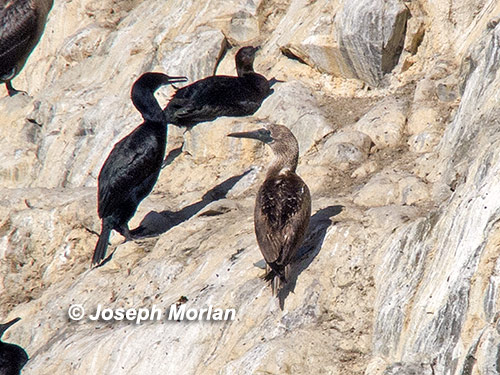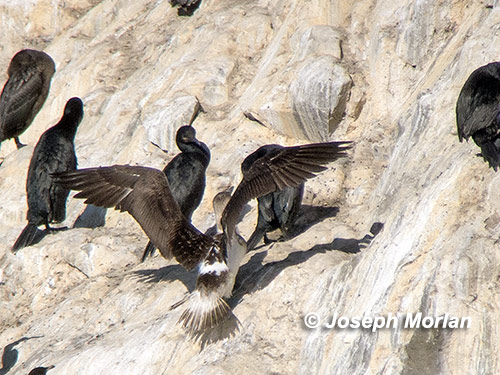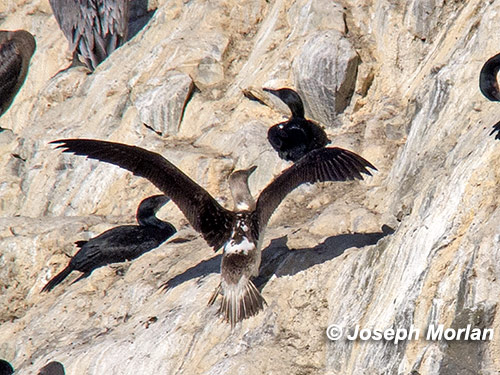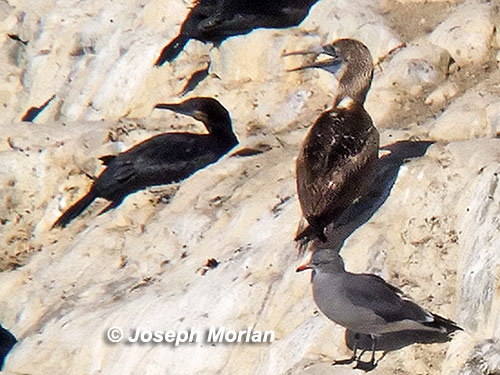
Showing the cone-shaped bill, narrow white forehead band, and gray foot.
Blue-footed Booby (Sula nebouxii nebouxii)
Arch Rock, Cliff House, San Francisco, San Francisco Co, CA
19 September 2013
Joseph Morlan
Photos © 19 September 2013 by Joseph Morlan. All rights reserved. Click
here for larger images and here for full size spread wing images.

Showing the cone-shaped bill, narrow white forehead band, and gray foot.
I believe this species was found here by Logan Kahle on 16 September. Two Blue-footed Boobies were seen and photographed here the next day. However these birds have not been reliable and were missed all day yesterday. When we learned that Brian Fitch had seen a Blue-footed Booby land on Arch Rock off the Cliff House this morning, Robbie Fischer and I decided to try for it. We arrived about 9:15am to find Brian still viewing the bird in his spotting scope. The booby was visible on the upper left side of Arch Rock. It spent much time preening but otherwise did not move from this spot during our visit. The bird was at a considerable distance; I attempted to digiscope it with the results seen here. However, most of my photos show the bird preening with its head and bill buried under its wings.

Wings spread showing white underparts, lower back and bases of tail feathers.
Description
The following description is based on memory and on photos:
This booby was slightly smaller than adjacent Brandt's Cormorants (Phalacrocorax penicillatus) but decidedly larger than nearby Hermann's Gulls (Larus heermanni). The bird spent almost the entire time actively preening, but it was invariably facing away so that details of its underparts were difficult to see. It had a large, dark-gray cone-shaped bill, long pointed tail and very long pointed wings. The uppeparts were mostly brown with the upperside of the wings fairly solid brown, showing some pale mottling only near the body. The back was slightly darker brown but more extensively mottled with buff fringes to its mantle feathers and white tips to some back feathers. The back of the neck had an obvious large white patch that separated the back from the head which was a paler gray-brown color. This color was formed by a fine pattern of dark streaks, rather than a solid color. The forehead had a narrow white band. The gular skin occasionally showed and appeared to be blue-gray (see bottom right photo).
The lower back had a bold white patch separating the back from the dark brown rump. The uppertail coverts were paler gray-brown. The long pointed tail-feathers were pale (whitish but not pure white) at the basal quarter and dark for the distal three-quarters.
The underparts were hard to see, but appeared mostly white. The underwings were sometimes seen briefly while the bird preened or spread its wings. They seemed to be white in the axillars and inner portion of the underwing, but dark distally. One photo seems to show a trace of a narrow dark bar within the white of the secondary underwing coverts.
Legs and feet seemed dark gray. The eye was pale with a very small dark pupil suggesting that it was a male. Female have larger dark pupils in this species.

Interaction with adjacent Brandt's Cormorant. Dark bill base and white nape mark showing.
Discussion
Status in California
Until this year, there were 114 previously accepted records of Blue-footed Booby in California. The species was removed from the CBRC review list in 1974 because it was thought to be of regular occurrence. It was restored in 1986 when it became apparent it was no longer a regular or expected visitor to the state. Major invasions occurred in 1969 (32 birds) and 1972 (at least 45 birds), but over 40 years have passed since then. Now we are experiencing what appears to be the largest invasion ever with more than 18 birds together at Obsidian Butte (Salton Sea), more than 10 on Anacapa Island and up to 7 at Playa Del Rey. Birds have been seen as far north as Bodega Head in Sonoma County, and one was reportedly photographed at Mono Lake. An eBird summary is here. John Puschock discussed this event in the ABA Blog and more recently this incursion has been summarized on the Farallon blog.
There has been considerable speculation about the cause of this invasion. It seems likely to be related to a combination of high reproductive success followed by declines in food resources. Sardine stocks may have been over-fished in the Gulf of California. There have also been reports of declines in anchovy off the California Coast.
Age
All the California birds appear to be HY (hatching year) suggesting that there was a good reproductive season. I believe that this bird is mostly in juvenal plumage, but appears to be growing a new p1 on each wing, suggesting that it is 6-8 months old. Click here for a page showing higher resolution spread wings with molt analyses by Howell and Pyle.
Cliff House Birds
Two different individuals were photographed here on 17 September by Michael Park. In comparing his photos, I believe our bird is the same as the one which he labeled as "immature," not the one labeled "juvenile" which was a darker individual. See external links below.
Identification
The pattern of white patches on the upper and lower back and pale uppertail coverts help distinguish Blue-footed Booby from any similar species. Juvenile Peruvian Booby can be similar but usually has darker underparts and lacks the distinct white patches on the back. Two races of Blue-footed Booby are recognized. California birds have been assigned to the nominate race. S. n. excisa is slightly smaller and confined to the Galapagos Islands.

Wings spread showing white nape, mottled back, white back patch and pale tail base.

Bill open showing bluish gular pouch and pale chin.